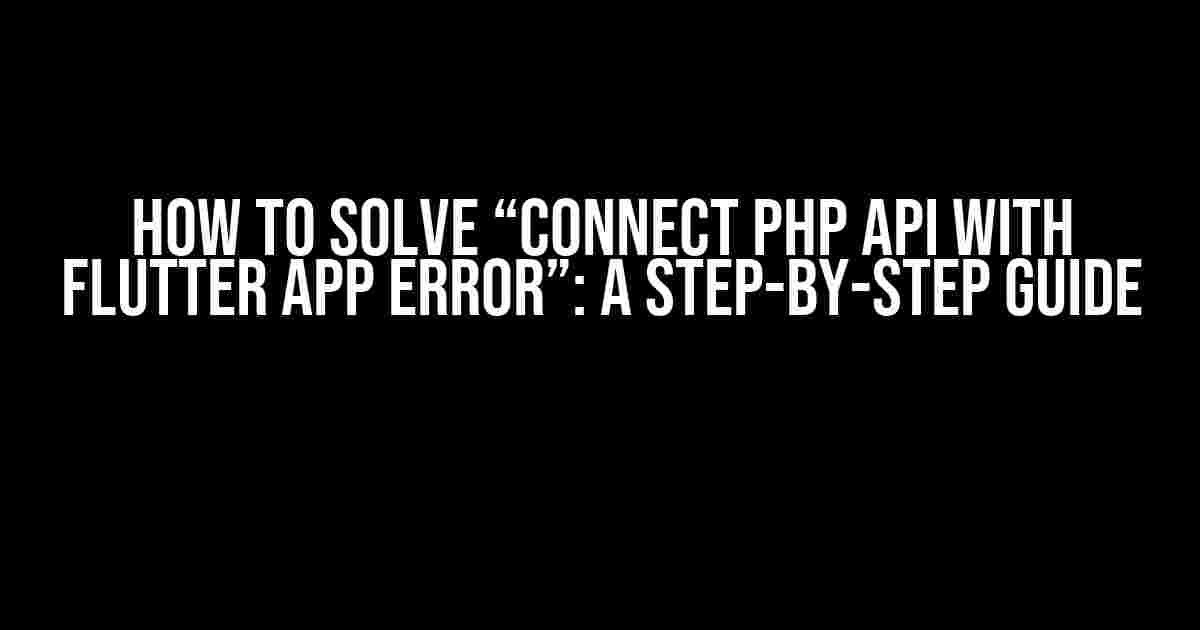Are you frustrated with the “Connect PHP API with Flutter App Error” message? Don’t worry, you’re not alone! This error can be a real showstopper for developers, but fear not, dear reader, for we’re about to delve into the world of Flutter and PHP APIs and emerge victorious on the other side.
What’s Causing the Error?
Before we dive into the solution, let’s take a step back and understand what’s causing this error in the first place. There are a few common culprits:
- Incorrect API endpoint URLs
- Invalid API requests (e.g., GET instead of POST)
- Mismatched data types (e.g., sending JSON data to a PHP API expecting XML)
- Authentication and authorization issues
- Network connectivity problems
Setting Up Your Flutter App
Now that we’ve identified the potential causes, let’s get started with setting up our Flutter app to connect with our PHP API.
Step 1: Add the `http` Package
In your Flutter project, open the `pubspec.yaml` file and add the following dependency:
dependencies: http: ^0.13.3
Then, run `flutter pub get` in your terminal to install the package.
Step 2: Create a New Dart File
Create a new Dart file, e.g., `api_service.dart`, and add the following code:
import 'package:http/http.dart' as http;
class APIService {
Future<http.Response> getData() async {
final response = await http.get(Uri.parse('https://example.com/api/data'));
if (response.statusCode == 200) {
return response;
} else {
throw Exception('Failed to load data');
}
}
}
This code creates a new `APIService` class with a `getData` method that sends a GET request to our PHP API.
Setting Up Your PHP API
Now that our Flutter app is set up, let’s create a simple PHP API to interact with.
Step 1: Create a New PHP File
Create a new PHP file, e.g., `api.php`, and add the following code:
<?php
header('Content-Type: application/json');
$data = array('name' => 'John Doe', 'age' => 30);
echo json_encode($data);
?>
This code sets the content type to JSON and outputs a simple data array.
Step 2: Set Up Your API Endpoint
Create a new API endpoint, e.g., `https://example.com/api/data`, that points to our `api.php` file.
Note: Make sure to update the API endpoint URL in your Flutter app’s `api_service.dart` file to match your new API endpoint.
Solving Common Errors
Now that we’ve set up our Flutter app and PHP API, let’s tackle some common errors you might encounter.
Error 1: CORS Policy Error
If you’re experiencing a CORS policy error, it’s likely because your PHP API is not configured to allow cross-origin requests.
To fix this, add the following headers to your PHP file:
<?php
header('Access-Control-Allow-Origin: *');
header('Access-Control-Allow-Methods: GET, POST, PUT, DELETE');
header('Access-Control-Allow-Headers: Content-Type');
?>
This code allows cross-origin requests from any origin, but you can restrict it to specific domains if needed.
Error 2: JSON Decode Error
If you’re experiencing a JSON decode error, it’s likely because your PHP API is returning invalid JSON data.
To fix this, make sure your PHP API is outputting valid JSON data using the `json_encode` function:
<?php
$data = array('name' => 'John Doe', 'age' => 30);
echo json_encode($data);
?>
This code ensures that our PHP API outputs valid JSON data that can be parsed by our Flutter app.
Conclusion
And there you have it, folks! With these steps, you should be able to connect your Flutter app with your PHP API without encountering the dreaded “Connect PHP API with Flutter App Error”. Remember to troubleshoot common errors like CORS policy and JSON decode issues, and don’t hesitate to reach out if you encounter any further problems.
Happy coding, and may the API connection be with you!
| Troubleshooting Tip | Error Solution |
|---|---|
| CORS Policy Error | Add CORS headers to your PHP API |
| JSON Decode Error | Ensure PHP API outputs valid JSON data using json_encode |
| Authentication Error | Implement authentication and authorization mechanisms in your PHP API |
| Network Connectivity Error | Check network connectivity and API endpoint URL |
- Check your API endpoint URL and ensure it’s correctly formatted
- Verify that your PHP API is outputting valid JSON data
- Implement error handling in your Flutter app to catch and display errors
- Use a tool like Postman to test your API endpoints and identify issues
Frequently Asked Question
Got stuck connecting your PHP API with your flutter app? Don’t worry, we’ve got you covered! Here are the most frequently asked questions to help you troubleshoot the issue.
Q1: How do I configure my PHP API to accept requests from my Flutter app?
Ensure that your PHP API is configured to accept cross-origin requests (CORS) by adding the necessary headers in your PHP file. You can do this by adding the following code: `header(“Access-Control-Allow-Origin: *”); header(“Access-Control-Allow-Headers: Content-Type”);`. This will allow your Flutter app to make requests to your PHP API.
Q2: What is the correct way to make HTTP requests from my Flutter app to my PHP API?
You can use the `http` package in Flutter to make HTTP requests to your PHP API. Import the package and use the `post` or `get` method to make requests. For example: `final response = await http.post(Uri.parse(‘https://your-php-api.com/endpoint’), headers: { ‘Content-Type’: ‘application/json’ }, body: jsonEncode({ ‘key’: ‘value’ }));`. Make sure to handle errors and exceptions properly.
Q3: Why am I getting a “404 Not Found” error when trying to connect to my PHP API from my Flutter app?
This error usually occurs when the URL of your PHP API is incorrect or not properly configured. Double-check that the URL is correct and that your PHP API is deployed and running on a server. Also, ensure that your Flutter app is using the correct URL and that there are no typos or formatting issues.
Q4: How do I handle JSON data responses from my PHP API in my Flutter app?
You can use the `jsonDecode` function in Flutter to parse JSON data responses from your PHP API. For example: `final jsonData = jsonDecode(response.body);`. This will convert the JSON response into a Dart object that you can use in your app.
Q5: What are some common mistakes to avoid when connecting my PHP API with my Flutter app?
Common mistakes to avoid include incorrect or malformed URLs, incorrect header configurations, and failure to handle errors and exceptions properly. Also, ensure that your PHP API is properly configured to accept cross-origin requests and that your Flutter app is making requests correctly. Testing and debugging your app thoroughly can help you identify and fix these issues.


